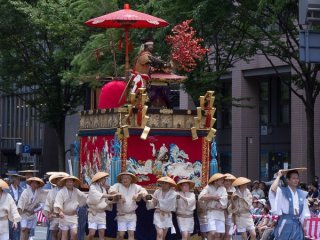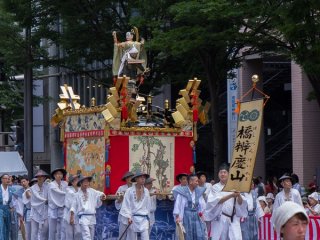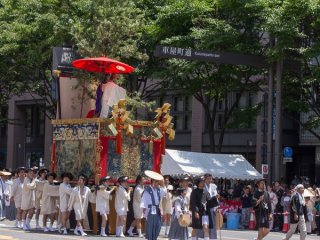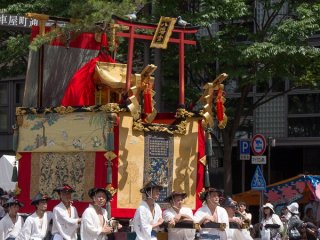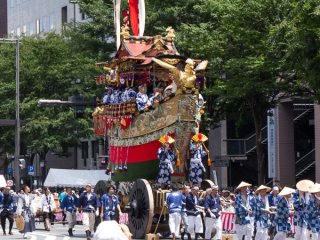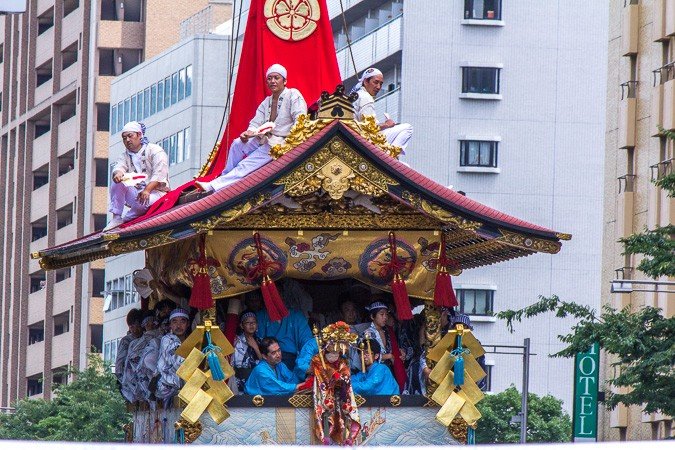
Houka-hoko (放下鉾) During the Yamaboko Junko (山鉾巡行) in Kyoto, 2012! This float derives its name from the small image of a Hoka-so priest near the middle of its center pole. Hoka-so appeared in the mid-Muromachi period (15th century) and are groups of Buddhist monks who traveled from place to place in rural Japan entertaining local people by performing a variety of stunts for the purpose of disseminating their faith

Houshou-yama (保昌山) During the Yamaboko Junko (山鉾巡行) in Kyoto,2012! This float features the famous love story between court poetess Izumi Shikibu and courtier Hirai Yasumasa. In the scene portrayed on this float the valiant Yasumasa, also called Hosho, dares to intrude into the Shishin-den, the very center of the Imperial court, to snap a branch from a noted red Ume tree (Japanese plum) to present it to this court lady that he admires
![Hashi-Benkei-Yama (橋弁慶山) During the Yamaboko Junko (山鉾巡行). This float derives its name from a Noh drama titled “Hashi-benkei” and features a famous scene in which Benkei, a warrior monk in armor with a long-handled sword, is fighting with the young Ushiwaka-maru, who stands on the parapet of the Gojohashi bridge on the Kamo River]()
Hashi-Benkei-Yama (橋弁慶山) During the Yamaboko Junko (山鉾巡行). This float derives its name from a Noh drama titled “Hashi-benkei” and features a famous scene in which Benkei, a warrior monk in armor with a long-handled sword, is fighting with the young Ushiwaka-maru, who stands on the parapet of the Gojohashi bridge on the Kamo River
![Hakurakuten-yama (白楽天山) During the Yamaboko Junko (山鉾巡行) in Kyoto, 2012! This float features a famous scene in which Hakurakuten (Po Chu-i) (772-846), a Chinese poet of the Tang dynasty, is asking the Zen master Dorin about the essential teaching of Buddhism]()
Hakurakuten-yama (白楽天山) During the Yamaboko Junko (山鉾巡行) in Kyoto, 2012! This float features a famous scene in which Hakurakuten (Po Chu-i) (772-846), a Chinese poet of the Tang dynasty, is asking the Zen master Dorin about the essential teaching of Buddhism
![Hachiman-yama (八幡山) During the Yamaboko Junko (山鉾巡行) in Kyoto, 2012! This float has a long history dating back to before the Onin wars (1467-1477), and has deity that come and settle down on it during Yoi-yama (the eve of the Gion festival) and on the Gion festival parade day]()
Hachiman-yama (八幡山) During the Yamaboko Junko (山鉾巡行) in Kyoto, 2012! This float has a long history dating back to before the Onin wars (1467-1477), and has deity that come and settle down on it during Yoi-yama (the eve of the Gion festival) and on the Gion festival parade day
![Fune-hoko (船鉾) During the Yamaboko Junko (山鉾巡行) in Kyoto, 2012! This float is based on a famous story about the legendary Empress Jingu of ancient Japan. After the death of her husband, and while pregnant with child, Empress Jingu armed herself and headed for war aboard a ship. This float as a whole is shaped like a boat and is enclosed with a vermilion parapet. On the front of the float is a mythical golden bird known as Geki]()
Fune-hoko (船鉾) During the Yamaboko Junko (山鉾巡行) in Kyoto, 2012! This float is based on a famous story about the legendary Empress Jingu of ancient Japan. After the death of her husband, and while pregnant with child, Empress Jingu armed herself and headed for war aboard a ship. This float as a whole is shaped like a boat and is enclosed with a vermilion parapet. On the front of the float is a mythical golden bird known as Geki
![En-no-gyoja-yama (役行者山) During the Yamaboko Junko (山鉾巡行) in Kyoto, 2012! This float has existed since the times before the Onin Wars (1467-1477) and is carried on the shoulders of people during the Gion festival parade]()
En-no-gyoja-yama (役行者山) During the Yamaboko Junko (山鉾巡行) in Kyoto, 2012! This float has existed since the times before the Onin Wars (1467-1477) and is carried on the shoulders of people during the Gion festival parade
![Ayagasa-hoko (綾傘鉾) During the Yamaboko Junko (山鉾巡行) in Kyoto, 2012! This is one of the parasol-type floats that are regarded as a prototype of the Gion festival floats. This float features a large parasol, and is accompanied by divine messenger boys known as “Chigo”, and a troupe of magicians and stick-twirlers during the parade]()
Ayagasa-hoko (綾傘鉾) During the Yamaboko Junko (山鉾巡行) in Kyoto, 2012! This is one of the parasol-type floats that are regarded as a prototype of the Gion festival floats. This float features a large parasol, and is accompanied by divine messenger boys known as “Chigo”, and a troupe of magicians and stick-twirlers during the parade
![Ashikari-yama (芦刈山) During the Yamaboko Junko (山鉾巡行) in Kyoto, 2012! This float is based on the Noh drama “Ashikari” (the Reed cutter). An old man, separated from his wife, is cutting reeds by an inlet in Naniwa (now Osaka). The story expresses the harmony between husband and wife as they are eventually reunited]()
Ashikari-yama (芦刈山) During the Yamaboko Junko (山鉾巡行) in Kyoto, 2012! This float is based on the Noh drama “Ashikari” (the Reed cutter). An old man, separated from his wife, is cutting reeds by an inlet in Naniwa (now Osaka). The story expresses the harmony between husband and wife as they are eventually reunited
![Arare Tenjin Yama (天神山) During the Yamaboko Junko (山鉾巡行) in Kyoto, 2012! Some 500 years ago, when a large fire broke out in Kyoto, hail suddenly fell from the sky and extinguished the fierce fire. Along with the hail stones a small image of Tenjin, the heavenly God of thunder, is also said to have fallen from heaven, which was the divine incarnation of Sugawara no Michizane, a renowned scholar and statesman who died a tragic death in 1903]()
Arare Tenjin Yama (天神山) During the Yamaboko Junko (山鉾巡行) in Kyoto, 2012! Some 500 years ago, when a large fire broke out in Kyoto, hail suddenly fell from the sky and extinguished the fierce fire. Along with the hail stones a small image of Tenjin, the heavenly God of thunder, is also said to have fallen from heaven, which was the divine incarnation of Sugawara no Michizane, a renowned scholar and statesman who died a tragic death in 1903
![Abura Tenjin Yama (油天神山) During the Yamaboko Junko (山鉾巡行), Gion Matsuri. Dating back to 869, this float enshrines Michizane Sugawara. Deified as Tenjin (Deity of thunder), a renowned scholar statesman who lived about 1,100 years ago.]()
Abura Tenjin Yama (油天神山) During the Yamaboko Junko (山鉾巡行), Gion Matsuri. Dating back to 869, this float enshrines Michizane Sugawara. Deified as Tenjin (Deity of thunder), a renowned scholar statesman who lived about 1,100 years ago.













